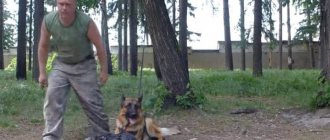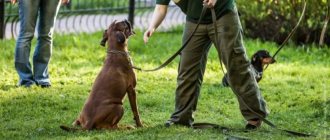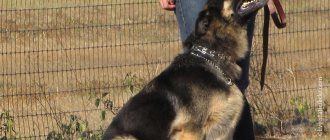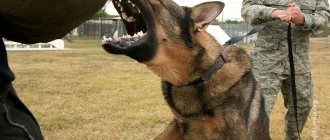Team "Stranger!" for dogs is part of the block of commands of the protective guard service (PSS). Such commands are aimed at protecting the owner, family, territory and property. Therefore, the command “Alien!” is practiced in parallel with the commands “Guard!” and “Fas!” We will tell you how to teach a dog the command “Stranger!” and what mistakes should be avoided when training.
Preparing for training: Photo
A little theory
Do not confuse the two orders “Alien” and “Fas”. The first is an intermediate step before training a dog to attack and actively defend.
What does the “Alien” command mean? If a stranger shows visible aggression, the animal should become wary, growl or bark actively, but under no circumstances should it rush at the person. In its literal sense, an instruction does not require the animal to perform specific actions, but puts it into a state of alertness or high alert.
You can start classes only after learning simple commands, such as “Sit”, “Lie down”, “Stand”, etc. provided that the latter are well studied and the animal obeys the first time.
The ideal age is six months and older; before this time it is better not to get carried away with training malice or aggression, otherwise the animal will grow up nervous and intimidated.
Things to consider before training a shepherd
Before starting training, the following conditions must be met:
- The person demonstrating the attack should not be familiar with the dog, and a person who does not like the animal is not suitable for training.
- During training, the attacker and the trainer should not communicate; they should be separated, otherwise the animal will not understand what is required of it.
- During training, the dog should never be hurt, only teased, irritated and caused slight discomfort. Otherwise, she may get scared, and the attempt to teach her to turn into ordinary defense, which does not mean protection. In such a situation, the dog will defend itself, but not the owner.
- There should be no children or other people in the area while working with the animal;
- After training with fabric, gradually switch to a special sleeve that is placed on the hand so that the dog can grab it.
- Remembering to praise and repeat the command is an integral part of the process.
- The last and most important point is that after a fight the attacker should always run away, this will let the dog know that he has won.
- The learning process is quite easy, but very dangerous. There is always a risk of being bitten, so it is worth remembering a strong leash so that the dog does not break loose, and a tight protective suit.
It is very important before starting to train any dog of the shepherd breed, be sure to pass the OKD, because without knowing the command “Fu!” the animal will be impossible to stop.
Is it worth learning
Before making a decision to teach or not to teach, you need to clearly determine for yourself whether it is really necessary to develop aggression in your pet and whether it can be subsequently controlled.
With improperly structured training, especially with dogs of an unbalanced excitable type, it is very easy to disrupt the psyche and instead of an obedient and friendly dog, you can “raise” an angry and uncontrollable beast.
This is how it was noticed:
- Dogs of large, service breeds undergoing training, even without targeted training, will protect their owner in dangerous situations, especially if friendly relationships have been established between them.
- On the other hand, small animals or representatives of decorative breeds, although they easily learn to show an active defensive reaction, but what is the point of this? Its non-intimidating appearance and small dimensions are unlikely to frighten anyone much.
- Problems are possible when inept training leads to hostility towards the owner or family members and such an animal literally becomes a killing machine.
There are also positive aspects: the puppy, and subsequently the adult animal, ceases to fawn and trust all passers-by or strangers appearing on its territory.
Necessary information
In fact, upon hearing the command “stranger,” the dog should under no circumstances rush at the newcomer. It is enough that he becomes wary, growls or starts barking loudly. That is, this task does not encourage the dog to take active action, but is only a signal to show alertness - the pet must be prepared for any outcome.
The dog should master this skill no earlier than he has mastered a set of basic commands - “place”, “sit”, “give me a paw”, etc. Moreover, he can begin training if he completes the remaining tasks the first time, unquestioningly obeying. Serious training should take place no earlier than six months, since the early development of viciousness or aggressive behavior can cause the dog to become nervous and intimidated.
Scheme of work
Teaching a dog the “Stranger” command is only possible with the help of helpers. It is important that they are not family members or close friends.
It is best for the classes to be conducted by an experienced instructor who will first determine the type of nervous activity of the dog and generally understand whether it is worthwhile to develop anger with a particular animal or not.
First of all, even before targeted training, it is necessary to ensure that the animal does not have contact from infancy, and certainly does not play with strangers. To do this, it is necessary to prohibit all friends and acquaintances from communicating with the pet; moreover, they must ignore the presence of the puppy. All attempts to fawn are warned by a weak tug on the leash and the warning command “Alien.”
Upon reaching the required age and subject to impeccable obedience to other commands, you can begin classes to develop anger, distrust and wariness towards strangers.
To do this, they involve assistants who are equipped with special protective equipment. The first classes are conducted in a quiet, familiar environment without distracting stimuli.
- The animal is kept on a short leash.
- The helper approaches those standing and shows aggression in any way: he waves his arms or a stick, while actively showing that he is afraid of the dog.
- At the same time, while continuing to hold the dog on the chain, they pronounce the command “Alien”. It is very important to use intonation to convey to the animal about the existing threat.
- If the pet shows any kind of hostility (growling, barking, or the dog begins to rush at the “stranger”), repeat the command again and reward the animal with a treat.
After a while, when the animal completely calms down and comes to its senses, the exercise is repeated. You cannot conduct lessons more often than two or three times in one lesson.
Team “Alien!” for dogs: recommendations from dog handlers
- All dogs show aggression in different ways. For example, a German Shepherd growls and barks loudly. Moscow watchdog or Brazilian fila attack without noise. Therefore, it is recommended to carry out training under the guidance of an experienced dog handler. To avoid sad consequences as a result of mistakes during training.
- Only dogs with a stable psyche can be taught ZKS commands.
- The specialist will assess the dog’s psyche and level of excitability. He will give recommendations on when to start training and how to carry it out.
- In any case, observe the dog from the day it appears in your home. The puppy's character and habits clearly manifest themselves during games.
- Do not teach the command “Alien!” at home.
- Don't ask friends and family to play the role of "attacker."
- Don't encourage your dog to bark at your door. Once the habit of barking becomes established, it will be difficult to get rid of it. A dog can show its alertness by growling menacingly, but not by barking.
- An “intruder” can only be a person unfamiliar to the dog. He must wear a special protective suit and mask to protect himself from harm.
Teaching a German Shepherd the “Alien!” command: Photo
If the dog is not aggressive
There are animals that do not show any malice towards a stranger. In such situations, it is necessary to compromise and bring in heavy artillery. Here are some ways:
- the assistant “attacks” the owner;
- the assistant imitates taking away food from the owner, which is intended for the dog;
- During the “attack” the ill-wisher inflicts light blows on the animal.
It is important not to overdo it with physical violence: the animal develops malice, not cowardice. Therefore, blows should not be strong or cause severe pain - they should only inflame aggression and active defense.
It is for this reason that the assistant must be experienced and carefully monitor the student’s behavior, and if necessary, retreat in time so as not to overwhelm the dog. The dog must always remain a “winner”!
Naturally, at the moment of manifestation of any kind of wariness or malice, they pronounce the command “Stranger” and reward the animal in a convenient way (affection, encouraging words, treats). It is advisable not to abuse taste rewards.
After some time, the animal develops an active defense, it becomes distrustful of any stranger and is no longer afraid of blows.
Team “Alien!” for a dog: what does it mean?
Team “Alien!” - warning the dog to be ready to attack. He shouldn't attack. For this purpose there is a command “Fas!”. The dog simply receives a signal that there is a dangerous person in front of him who is capable of causing harm.
The dog's execution of the command “Stranger!” often avoids an attack or fight. If a large dog clearly shows aggression and readiness to attack, this is enough to frighten the attackers.
Therefore, when following a command, the dog is encouraged to show aggression. For example, show a grin, bristle, growl, bark. Take a throwing position.
Other training methods
There are alternative methods for teaching a dog the “Alien” command:
- If during a walk the animal independently shows hostility towards a person passing by, then at the same moment the words of the command are pronounced.
- Again, during the walking process, they use the method of surprise, which helps even the most timid pet to awaken the beginnings of protective behavior. To do this, the assistant sneaks up behind the dog and lightly pinches its croup or belly, at the same moment the trainer says “Stranger.” Important: the student must be muzzled, while carefully monitoring the pet’s behavior - this method may not always lead to the desired result and instead of malice, caution will be practiced, and the dog will look around in fear of getting another blow.
Teaching a dog to bark at strangers
Almost all breeds can learn to bark at strangers. Well amenable to training:
- German Shepherd;
- Rottweiler;
- Staffordshire Terrier;
- Boxer and other fighting dogs, as well as protectors.
Such breeds by nature react by barking at strangers. When training them, at the moment of barking, the main thing is not to stop performing certain actions, but, on the contrary, to force them to bark even more and longer. To do this, you need the help of strangers who are not familiar to the animal. During training, the pet must be on a leash so as not to harm people. Upon completion of the training, the owner must say “” in a calm voice and pet the animal. You need to achieve such a result that when you appear, the dog stops barking.
Currently reading:
- Making the dog obedient by socializing it
- Five ways to stop a dog from barking
- Features of the character and upbringing of the Australian Shepherd
- Why does a dog bite and how to stop it from doing so?
Possible mistakes
Mistakes always lead to undesirable and unexpected results - improper training will lead to excessive aggression, and superimposing malice on natural cowardice can cost the life of the owner or those around him.
- Protection training begins after six months of age (the later the better). Until this moment, the pet must live and grow exclusively in friendly conditions.
- Only strangers are recruited as assistants. By the way, the assistant in each lesson should be different, otherwise an active defensive reaction will be developed exclusively against a specific person.
- During work, the animal is not allowed off the leash and is not allowed to attack an ill-wisher.
- Training is carried out only after mastering the basic disciplinary commands: “Sit”, “Come to me”, “Fu”, “Next”, etc.
- Punishment cannot be applied in the absence of correct actions, otherwise the animal will be even more afraid.
- Also, you should not punish your pet if he continues to show good nature to the first person he meets. At such moments, the puppy is distracted, and people are forbidden to make any contact with the baby.
With the right approach, the “Alien” command can be useful in everyday life: it will not give the opportunity to steal an animal, and a growl can scare an intruder, which will ultimately protect the owner from attack.
Train a dog to be mean to strangers
Sometimes it is necessary to teach a pet to be angry towards strangers, and also to teach it to bark at strangers. Such methods are used by the owners of private houses and various enterprises where strangers may enter. When a dog has close contact with its owner, sometimes there is no need to cultivate anger. But in most cases, owners turn to a dog handler for help. Only a specialist can help set up training correctly.
Before this, the dog handler must warn that such a command can be dangerous for people around him, that you need to understand the seriousness and know how to pacify the dog. You need to teach an animal to be angry towards strangers from a very early age. By the age of 4 months, the dog should already know the commands “fu”, “come to me”, “stranger”. With the help of a dog handler, you will teach her to be aggressive when you order her. By teasing the dog and catching it, the dog handler will show by his own example that a stranger is dangerous and that action must be taken immediately.
After such activities, you need to behave calmly and restrainedly, praise your pet and give various treats. An experienced trainer will teach you how to develop anger and be wary of strangers after just 5-7 lessons. The main thing is to deal with aggression correctly and quickly calm the animal after such actions.
Is it necessary to master the “alien” command?
This command is not always required, and the owner must first weigh everything: whether the pet needs to develop aggression, and whether the owner himself has enough strength and influence to control its manifestations.
Incorrect training, especially when it comes to dogs with an unbalanced psyche, can lead to the animal growing up angry and uncontrollable. Experienced breeders and dog handlers note a number of features:
- Large service dogs, even without additional training, rush to protect their owner if a dangerous situation arises, especially if their relationship is based on friendship and trust.
- Owners of dogs of decorative breeds will not receive any benefit from training such a command. It is unlikely that a tiny Chihuahua or lapdog will cause fear in anyone, even if they bark furiously.
- If improperly trained, a dog can show hostility towards its owner or family members; naturally, such an animal is very dangerous.
Among the positive aspects, it can be noted that the pet will not fawn and trust everyone passing by or entering its territory.
Various techniques
There are several methods for teaching your pet the front command yourself.
All of them are trained on a leash.
Method 1
- The dog stands next to the owner on a soft collar or harness.
- The assistant comes out of hiding and begins to sneak up on the animal, bending down and arousing suspicion with his behavior.
- The owner encourages the dog with the command “stranger”.
- Having approached five steps, the assistant turns around and runs away, the dog tries to grab him, the command “Face!” is given.
This technique is well suited for insecure, timid animals. There is no direct interaction with the enemy.
Method 2
- The pet is on a leash, a favorite toy or bone lies nearby, the assistant walks by, pretending to try to grab the thing.
- The dog begins to break from the leash, trying to bite the intruder, pronouncing “fas!”
The method works well with angry, suspicious dogs.
Method 3
- The dog is tied to a post or tree, the owner stands nearby.
- The assistant passes by several times, teasing the dog with a rag and running away, the owner says “stranger.”
- When the pet gets angry, the assistant approaches the owner and pretends that he wants to attack him.
- The owner shouts: “Face!”, pushes the enemy away; if the dog tries to bite, the rag is given to it, and the assistant “runs for his life.”
Method 4
- In the courtyard of a private house, you can stage an attempt to break in by robbers.
- To do this, the assistant makes suspicious noises and rustles behind the fence, tries to look into the yard, opens the gate and sticks his jacket through it.
- Attempts by a pet to grab a thing, barking at a stranger are encouraged by the word “stranger!”
- This lasts no more than five minutes, then the dog is put on a leash, the owner takes it out the gate, and at the command “Face!” begins to pursue the assistant.
You can let the dog catch up with the person and grab the rag or jacket that he leaves behind.
Basic
The earlier training begins, the more impressive the results will be. You can start learning basic commands from the very first day the puppy is with the owner.
It is the impeccable execution of basic commands that will help the owner avoid unpleasant situations (for example, the indignation of a passerby whose clothes have been soiled by a running puppy) and will ensure the safety of the pet itself (in particular, the “come to me” command will force the dog to run up to the owner, and not go out onto the roadway).
The list of basic commands is small, but each of them must be carried out by the dog
without delay .
The first thing you should teach your shepherd dog is the “come to me” command. It is given by the owner when the pet needs to be called. To accustom it to it, you should say “come to me” when the dog is called for feeding, to pet or play with it, and so on - that is, the shepherd dog must know that after approaching it will receive a pleasant reward. After the Kafka dog came up and received praise, it was released with the word “walk.”
Important ! You cannot punish a dog if it does not immediately run up to the owner, and it is also prohibited to independently move towards the puppy. As soon as your pet approaches, you should immediately praise him and treat him with a treat.
“No” and “Fu” are used by owners to stop unwanted actions of the pet. It is better to practice them in a confined space or while keeping the dog on a leash. In the first case, a dog performing an undesirable action is punished with a gentle slap (for example, with a rolled up newspaper) and a spoken word, and in the second, with a sensitive tug of the leash, and the action is accompanied by a command.
The owner needs to be consistent - he should not allow the dog at a young age to do things that would be prohibited for an adult pet.
The algorithm for teaching a shepherd dog other commands is as follows:
- “Sit” - the puppy stands in front of the owner, who has a treat in his hand. The owner holds the hand with the treat above the dog’s head, while simultaneously pressing the puppy’s croup with the other hand and says “sit.”
- “Lie down” - performed by the dog from a sitting position. The owner passes his hand with a treat clamped in it in front of the dog's muzzle forward and down to the ground. Actions are accompanied by a single pronouncement of the command word.
- “Nearby” - the puppy is led on a leash so that the front part of its body is in line with the owner’s leg, and when the owner stops, the dog must sit down. Attempts to move away from the owner are stopped by a jerk of the leash, and correct execution is encouraged.
Important ! Practicing basic exercises begins with 1-3 repetitions, and over time their number increases. The main thing is to finish classes before the puppy gets tired, then he will not lose interest in training
A puppy should not be taught the “voice” command from early childhood, since the really important skills have not yet been learned and wasting effort and energy on this training will take a lot of effort from the baby.
Advice from professionals
Dog handlers believe that not just any pet can be trained to become a dog, but there are also those who are born specifically for this. Thus, the East European Shepherd very quickly learns the “front” command due to its innate tendency to protect the owner.
It is also important to teach this command to Rottweilers, but it will require more effort. The fact is that these dogs, for the most part, try to lead in relationships
This means that the owner will need more effort to subordinate the Rottweiler to his will.
You cannot abuse the command and set your pet on fire without a good reason, otherwise its behavior may become unpredictable.
We invite you to watch a video of owners and dog handlers teaching dogs the “Fas” command.
If you feel that your pet has already completely mastered the “face” command, then you should not give up training; it is better to return to training from time to time so as not to lose skills. Repeat the “fu” command periodically.
During training, the assistant and the dog's owner should not communicate. If the dog notices that they are communicating nicely, he will not understand what exactly is required of him.
Try not to be soft during training, try to be quite strict. The dog must feel that you want to achieve results from him.
Not all dog breeds are equally amenable to teaching the “face” command. For example, a shepherd dog can be trained after a few trainings, as it has good innate attack instincts. Rottweilers are more difficult to train; they exhibit leadership qualities from birth, which poses an obstacle to team training
Therefore, it is important to consult with a dog trainer about a particular breed: to know their psychological characteristics and how to approach training.
It is much easier to train a dog at a young age than an adult dog. So the sooner you start, the better.
The small animal has great trust in you, which will be an excellent basis for teaching the “face” command.
Do not include other animals in the training process. Your pet may perceive them as competitors, which will make him jealous.
Learning the “fas” command is a rather labor-intensive process that requires a lot of time and patience. If your dog fully masters this command, you will be under good protection. The “front” command is best used in vital situations when protection is necessary.
Never use a dog attack among friends, relatives, or loved ones, even in a playful or joking manner. This can lead to dire consequences
Know that any animal is first and foremost a predator, so it is important to take precautions
Ways to teach a dog to guard
How to establish relationships with an animal that will perceive strangers as a potential threat. You will need to devote a lot of time and effort to learning. The animal must be well walked and fed. After which he is placed in a familiar environment where the dog feels comfortable and safe. You can teach the necessary actions in a few days, the main thing is to repeat the lessons periodically. One of the effective techniques in studying:
Tie near the enclosure or house. At a distance, place a treat or an object familiar to the dog (maybe a toy). The dog should clearly see the object lying near it, but not reach it. Order to guard. After which, a stranger should pass near this object. If the dog reacts by barking, you need to approach, lightly touch and give the command to sit. This way the pet will feel safe, but at the same time, the importance of the actions taken to protect the item.
Frequent repetition of such actions over several weeks will lead to the animal perceiving every object you point to as protected. The main thing when performing actions is to be calm, not to raise your voice, not to frighten or punish the animal. Only in a calm state can you quickly learn new commands.
Alien team
For your own safety, you need to teach your dog a stranger’s command. This is necessary for any breed, even if the animal is not used for guarding purposes. Many pet owners cannot at first distinguish between the commands fetch, face and alien, in fact they only confuse the animal and train it incorrectly.
The essence of the order is to make one be wary when the owner utters these words. The pet should be calm when it sees a stranger, but it is possible to expect any actions directed at the owner. This action will allow you to be ready to protect and defend your owner. At these words, most breeds come forward in front of the owner to take the possible first blow. Before teaching your pet this command, you need to learn the commands “fu” and “come” well. It is better to start training as early as possible; an adult will most likely not master the teaching.
To learn, you will need the help of a friend. Your friend should take a stick or other large object and approach you waving and yelling at the dog. The animal may be tied or on a leash at this time. During these actions, the owner must repeat the order of the stranger. If the dog reacts by barking and growling, you need to pet it and praise it.
During classes to learn a stranger's command, you should not give the dog a treat. The animal may become distracted or choke. It's better to just praise the dog.
If the dog lies down at the command and covers its muzzle with its paws, then the standard technique is beyond its power. In such cases, they resort to a more severe method - a stranger quietly approaches and pinches the hind paw, at which point the owner must say the words “stranger”. After several sessions, such actions are associated with negative emotions. And the word of a stranger will be perceived with wariness and readiness to defend.











